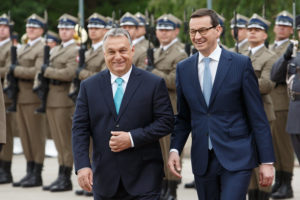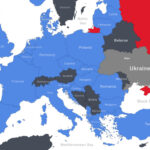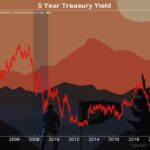
2018.05.14 Warsaw | Polish Prime Minister Mateusz Morawiecki (right) walks with Hungarian Prime Minister Viktor Orbán (left). Fot. KPRM
At The American Conservative, Rod Dreher highlights the work of Christopher Caldwell in explain Hungarian Prime Minister Viktor Orban. Orban recently met with President Trump, and the two share a view of nationhood that seeks to protect citizens above all else. The question for European voters in the upcoming EU parliamentary elections is, do they subscribe to the vision of Viktor Orban, or Angela Merkel? Dreher writes (abridged):
“Far right” — that’s the smear US and UK media apply to all European populist politicians and parties, as if they were all fascists. There is plenty to criticize in these politicians and movements, but the standard left-liberal view that they are fascists is not only stupid, but it’s simply wrong. You will not understand European politics if you rely on the US and UK mainstream media to explain this to you.
Here’s something that’s a lot more useful. It’s Christopher Caldwell’s Claremont Review of Books essay about the meaning of Orban. It’s well worth your time. Here’s how it begins:
No English-language newspaper reported on it at the time, nor has any cited it since, but the speech Hungarian prime minister Viktor Orbán made before an annual picnic for his party’s intellectual leaders in the late summer of 2015 is probably the most important by a Western statesman this century. As Orbán spoke in the village of Kötcse, by Lake Balaton, hundreds of thousands of migrants from across the Muslim world, most of them young men, were marching northwestwards out of Asia Minor, across the Balkan countries and into the heart of Europe.
Already, mobs of migrants had broken Hungarian police lines, trampled cropland, occupied town squares, shut down highways, stormed trains, and massed in front of Budapest’s Keleti train station. German chancellor Angela Merkel had invited those fleeing the Syrian civil war to seek refuge in Europe. They had been joined en route, in at least equal number, by migrants from Iraq, Iran, Pakistan, Bangladesh, Afghanistan, and elsewhere.
Orbán was preparing a military closure of his country’s southern border.
“Hungary must protect its ethnic and cultural composition,” he said at Kötcse (which more or less rhymes with butcher). “I am convinced that Hungary has the right—and every nation has the right—to say that it does not want its country to change.”
Migrants kept coming, and the European mood shifted. In Germany, Alternative for Germany (AfD), a party founded by economists to protest European Union currency policy, shifted its attention to migration and began to harvest double-digit election returns in one German state after another. The Polish government fell after approving a plan to redistribute into eastern Europe the migrants Merkel had welcomed. But if any European politician symbolized this reassessment, it was Orbán. Signs appeared at rallies in Germany reading “Orban, Help Us!” His dissent split Europeans into two clashing ideologies. With the approach in May 2019 of elections to the European Union parliament, the first since the migrant crisis, Europeans were being offered a stark choice between two irreconcilable societies: Orbán’s nationalism, which commands the assent of popular majorities, and Merkel’s human rights, a continuation of projects E.U. leaders had tried to carry out in the past quarter-century. One of these will be the Europe of tomorrow.
Read more here.
President Trump Participates in a Bilateral Meeting with the Prime Minister of Hungary
If you’re willing to fight for Main Street America, click here to sign up for my free weekly email.





